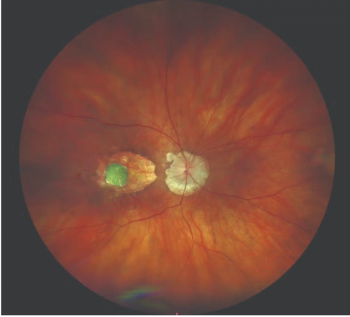
- Modern Retina May and June 2025
- Volume 5
- Issue 2
Highlights from ARVO 2025
Retinal imaging and the future of early Alzheimer diagnosis.
At the
Johnson, MD; Sandra S. Stinnett, DrPh; Dilraj Grewal, MD, FASRS; and Sharon Fekrat, MD, FACS, FASRS, whose mentorship and guidance were invaluable.
The motivation behind this study is based on previous work suggesting that the eye, specifically the retina, might serve as a noninvasive window into the brain. AD, the most common form of dementia, remains difficult to diagnose early using tools like PET scans or lumbar punctures, which are invasive, expensive, or inaccessible to patients. However, the retina, with its shared embryological and anatomical features with the brain, offers a compelling alternative, leading to the question: Could it reveal early changes in those with a genetic predisposition to AD?
The study centered on the APOEε4 allele, the strongest genetic risk factor for sporadic AD. We categorized participants into 3 groups: cognitively normal individuals who do not carry the APOEε4 gene, cognitively normal individuals who carry the APOEε4 gene, and people with symptomatic AD. Using OCT and OCT-A scans from the Zeiss Cirrus HD-5000 AngioPlex platform, we collected detailed retinal imaging data. We excluded individuals with comorbidities like diabetes, glaucoma, or retinal diseases that could confound our results, and we also controlled for age and sex in our analysis.
In total, we analyzed imaging data from over 970 eyes. A major aim was to investigate whether retinal microvascular and structural changes could be detected in people who are cognitively normal but carry the APOEε4 allele, potentially signaling early stages of AD-related pathology.
As we reviewed the results, we found that cognitively normal carriers of APOEε4 had reduced vessel and perfusion densities in the macular region compared with noncarriers—specifically in the 6-mm circle and 6-mm inner ring zones. Although these differences were not numerically large, they were statistically significant, suggesting that these subtle microvascular changes might occur before symptoms of cognitive decline appear.
We saw similar reductions in vessel and perfusion densities in the 6-mm zones when comparing patients with symptomatic AD with the noncarrier group. Interestingly, we did not detect significant differences in structural OCT parameters like central subfield thickness, ganglion cell-inner plexiform layer thickness, or retinal nerve fiber layer thickness.
This pattern—where microvascular changes emerge before clear structural alterations—suggests that microvascular disruption might be one of the earliest changes in the progression to AD.
Another interesting finding came from the peripapillary region. Here, we found that capillary perfusion density was higher in participants with symptomatic AD than in APOEε4 carriers and noncarriers. This may reflect the different disease stages being captured depending on the time point at which patients are imaged. It is possible that peripapillary changes evolve differently from macular changes. This increase could be a compensatory mechanism to hypoxia brought on by amyloid changes, or it could also be an artifact of disease progression. These spark new questions and areas for future investigation.
In summary, our findings provide new evidence that retinal microvascular changes are detectable in cognitively normal individuals carrying the APOEε4 allele, and that these changes are similar to those seen in people with symptomatic AD. This suggests that retinal imaging may be used to identify individuals at higher risk for AD before cognitive symptoms arise—an interesting and powerful thought.
The broader implications of this project are exciting. If these findings are validated in larger, longitudinal studies, we might one day integrate retinal imaging into routine eye exams as a screening tool for Alzheimer risk. This could allow for earlier intervention, whether through lifestyle modifications, pharmacotherapy consideration, or advanced care planning, for cognitively normal individuals at increased risk of progression to AD.
Ultimately, what excites me most about this work is its potential to bring brain health into the eye clinic. With technology we already have at our disposal, we may be able to help patients see more clearly into their cognitive futures. I will be submitting this work for peer review soon, and I am hopeful it can contribute to the growing conversation around retinal imaging as a window into neurodegenerative disease.
Alex Choi
Choi is an MD candidate, Class of 2027, at Duke University School of Medicine in Durham, North Carolina, and a member of the Duke iMIND Research Group. This is a multidisciplinary group working to understand the potential of multimodal retinal images combined with machine learning techniques. The group is working under its director, Sharon Fekrat, MD, FACS, FASRS, among other faculty members of the university.
Reference
Choi A. Multimodal retinal imaging in asymptomatic APOE ε4 carriers, APOE ε4 noncarriers, and alzheimer’s disease. Association for Research in Vision and Ophthalmology 2025 Annual Meeting; May 7, 2025; Salt Lake City, UT.
Articles in this issue
Newsletter
Keep your retina practice on the forefront—subscribe for expert analysis and emerging trends in retinal disease management.












































